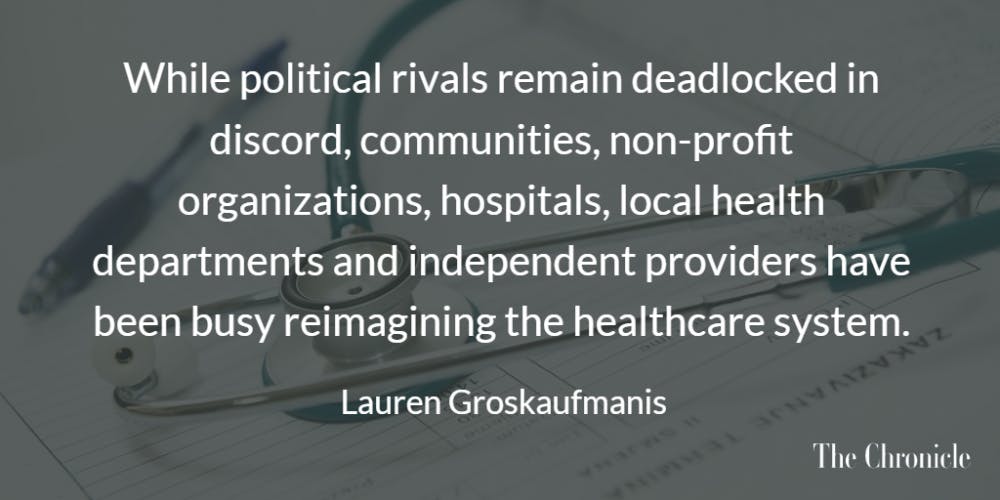At times, writing about the American healthcare system can feel a bit like pulling the fire alarm in a burning building. Many still cling to notions of American exceptionalism—unwavering in their belief that the American healthcare system in the best is the world. As such, I often feel like my writing is an attempt to dispel these illusions with a firm dose of reality. Simply put, the cost of care in our nation is a terrible burden to the individual and the collective nation. And, simply put, our health outcomes increasingly lag behind nations of similar wealth and technological advancement. Widespread awareness of this reality is critical to creating the sense of urgency necessary for meaningful change.
If the first step of addressing a problem is admitting you have a problem, the next step is figuring out what to do about it. Recent political machinations suggest that reform on a national level will not be a driver of change in the near future. Bipartisan cooperation, or even uni-partisan cooperation, seems difficult to muster. While national and state level policies are powerful drivers of reform, they do not represent the only means through which change can be enacted. This week I was fortunate hear Dr. Lloyd Michener, the chair of the Duke Department of Community and Family Medicine, speak to the Family Medicine Interest Group. Dr. Michener’s talk acknowledged the more depressing realities of the American healthcare system, before expanding in scope to address a critical question: what are we going to do about this? He is able to speak authoritatively on the issue, given his own personal involvement in initiatives to improve the health of communities and reimagine the relationship between academic medical centers and the communities they serve.
One example of reimagined healthcare looks to the past for inspiration—house calls. Once a staple of medical care, these visits allow providers to take into account medical, as well as environmental, challenges. Is there food in the fridge and pantry? Is there mold on the walls? Are prescriptions filled? The benefit are also logistical—patients who are housebound may not seek medical care because they are physically unable to reach a doctor’s office. While house calls may seem like a tool of the past, they are experiencing a resurgence, as evidence demonstrates reduced cost and improved patient health. A Medicare demonstration project found that home visits were successful in keeping recipients with multiple chronic illnesses out of hospitals, emergency rooms and nursing homes, and resulted in per-patient costs savings of $1,010 per year. Just for Us, a Duke-affiliated program offering home-based primary care to low-income seniors in Durham, was successful in diverting funding from inpatient and emergency care to preventative care. In 2013, 5,000 primary care providers conducted 1.7 million house calls across the country.
Hotspotting initiatives are another innovative method of reimagining care delivery. Vast troves of data are analyzed to discover patterns of health care utilization. The data can be used to identify patients who utilize the system at an unusually high rate or utilize the system inefficiently (such as going to the ED for a non-urgent concern). This knowledge creates the potential for intervention, by addressing barriers the health care access, psychosocial stressors and the behavioral choices that exacerbate disease. While this approach was pioneered by groups such as the Camden Coalition, in Camden, NJ, similar efforts are being carried out at Duke. Medical students have the opportunity to participate in a hotspotting initiative with the Duke Outpatient Clinic, and are paired with patients who use lots of healthcare services. Working with an interdisciplinary team of healthcare professionals, the students support patients in making changes that reduce their risk of chronic disease.
Another innovative model—the Community Asthma Initiative—was founded to address health disparities in the city of Boston, where Black and Latino children are hospitalized for asthma at a rate 5 times higher than White children. The initiative is unique in providing comprehensive wrap-around support to children with asthma. This includes medical management of asthma, as well as home visits to help families identify and ameliorate asthma triggers. The program provides the tools needed to address triggers, such as HEPA vacuums or bedding covers. Social work services address issues such as substandard housing or lapses in insurance that are additional barriers to asthma control. The results for participants are impressive: a 57 percent reduction in ED visits, a 79 percent reduction in hospitalizations and a 43 percent reduction in missed school days. The costs of providing this comprehensive care are more than recouped by the reduction in hospital expenses.
For many years “innovation” in the American healthcare system has meant a novel surgery, a new class of drugs, or a new medical device. While there are certainly benefits to these treatments, they do not address flaws in the underlying structure of the healthcare system. I see innovation as truly addressing the social determinants of health: poverty, homelessness, prejudice, environment and education. I see innovation as designing healthcare that is coordinated and proactive, rather than reactionary. An innovative system addresses the practical challenges of everyday life and intervenes to address lifestyle as a driver of health and disease. Innovation relies on data to tailor resources for maximum impact and efficiency.
While political rivals remain deadlocked in discord, communities, non-profit organizations, hospitals, local health departments and independent providers have been busy reimagining the healthcare system. Dr. Michener’s speech reminded me that many people are not waiting for national or state leaders to reform healthcare, but are out in communities, working to enact change and demonstrating impressive results. We do not have to wait for national policy reform to make revolutionary changes on a local level and make a meaningful impact on the lives of patients.
Lauren Groskaufmanis is a graduate student in the school of medicine. Her column, “the picture of health,” runs on alternate Fridays.
Get The Chronicle straight to your inbox
Sign up for our weekly newsletter. Cancel at any time.

